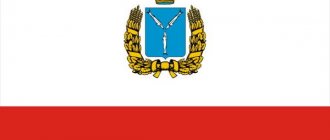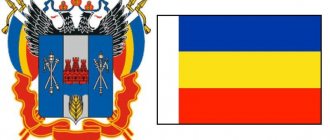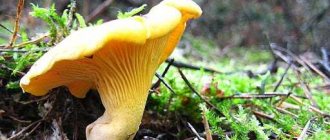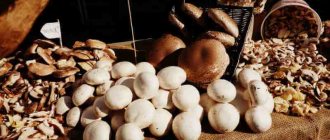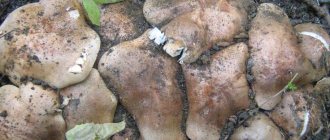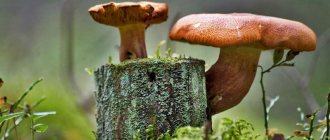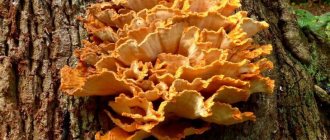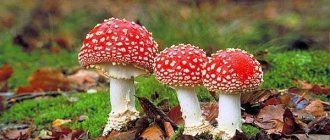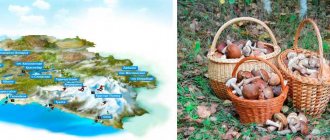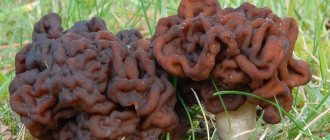Mushrooms
0
2742
Article rating
Kira Stoletova
Mushrooms of the Saratov region come in a wide variety of varieties. From noble whites to saffron milk caps and russula. At the same time, there are quite a lot of mushroom places here and a mushroom picker who knows the area will never return home with an empty basket.
Mushroom picking in the Saratov region
The area is divided into 2 parts by the Volga River. The concentration of forest plantings is on the right bank. There are more deciduous trees here. The map of mushroom places in the Saratov region includes many settlements where there are forest plantations. You should become familiar with the area in order to choose the most optimal “mushroom” route.
The most mushroom places in the Saratov region are Tatishchevsky, Baltaysky, Petrovsky and Bazarno-Karabulaksky districts.
Popovka village
Here is the closest mushroom forest to the city of Saratov (and, accordingly, the regional center). It stretches between the villages of Popovka and Sosnovka. Mushroom pickers travel from Saratov by bus towards the village of Sbrodovki. A road leads to the forest from this village, but the forest itself grows in the tract. The places here are uneven, with elevation changes, so in search of mushrooms, you will have to climb steep and lowlands.
The forest is old, pine. Trees are 100-200 years old. Pine plantations are adjacent to oak forest. Boletus, boletus, and saffron milk caps grow here.
Irina Selyutina (Biologist):
Mushrooms are living organisms, like all life forms on our planet. And they are also affected by parasites. And one of these parasitic fungi, the species Pekiella brick-red from the family Hypomycetes, has chosen the fruiting bodies of saffron milk caps. As studies have shown, during its development, its mycelium causes a reduction (simplification) of the hymenophore plates and almost completely covers the entire lower side of the cap. Such saffron milk caps are called “stone” or “deaf”. Their plates are not able to form spores. Experts do not recommend collecting such fruiting bodies.
There are many other mushrooms too. There are volushki, milk mushrooms, rows, talkers.
Light industry
Light industry in the region is represented by textile factories, knitting factories, shoe production and the neck industry. Textile production is concentrated in Krasny Tekstilshchik, Krasnoarmeysk and Engels. The leading enterprise in this industry is the Balashovsky Raincoat Fabric Factory Baltex. It was built in the middle of the last century and occupies a leading position in the production of silk fabrics in the country to this day. But in general, light industry in the region is poorly developed and cannot fully satisfy the needs of the population.
urban village Bazarny Karabulak
Saratov is located 100 km from this area. Both deciduous and coniferous trees grow here. The forest is mixed, of different ages. Perennial trees are found everywhere, but there is also undergrowth of oak, pine, and maple. The main attraction is the centuries-old ship pines, which are 150 years old or more.
Mushrooms of this area:
- Butterflies are often found in the grass.
- Greenfinches grow in groups, burying themselves up to their caps in the sand.
- Near pine trees or at the edges of plantings, in lowlands, ditches, one encounters a type of porcini mushroom with a thin (cylindrical) stalk and a yellow-brown cap.
- In pine forests, wet lowlands, clearings, and forest edges, saffron milk caps are often found. They do not grow singly, but in whole groups.
Ryzhiki belong to the I category of edibility. Their most important advantage over many other equally valuable vitamins and mineral compounds is that they do not need to be pre-soaked. Simply wipe with a damp cloth, remove any adhering forest debris and cut off the hard lower part of the leg.
It is interesting that one type of saffron milk cap, due to the presence of special pigments in the fruiting body, can cause urine to turn red.
When collecting mushrooms, you need to carefully examine each specimen that you are going to send to the basket: if it raises your doubts, it is better to leave it where you found it, but hanging it on a branch - i.e. you will help the spores spread with the help of the wind and after a while you will get a few more mushroom spots.
Well, what about the taste?
Sandpipers are ideal mushrooms for pickling. They are easy to prepare, and in 35-40 days you will become the owner of a delicious snack. To do this you will need a wooden tub or glass bottle. The mushrooms need to be washed and carefully laid in layers, sprinkled with coarse salt. Moreover, it is worth putting more of it at the bottom and from the very top. We install a lid and a slight bend on top of them. After a couple of days, the mushrooms will settle, then you can lay a couple more layers on top.
Thanks to this method of dry pickling, the mushrooms will be tender, aromatic and extremely tasty.
Yagodnaya Polyana village
A huge forest area is located between four settlements of Tatishchevsky and Petrovsky districts. It starts behind the village of Yagodnaya Polyana and continues to the villages of Ozerki, Orkino, Sokur. The forest is a mixture of deciduous trees with small patches of pine.
Here you can find boletus, boletus, boletus, and honey mushrooms. There are milk mushrooms, as well as pig mushrooms, russula of different colors, rows, talkers, and umbrella mushrooms.
Do you know about umbrella mushrooms that ...
- Only some of the umbrella mushrooms belong to the genus Macrolepiote (umbrella mushroom), while the rest are scattered among other genera.
- The diameter of the cap of some species can reach 35 cm, with a stem length of 40 cm.
- Most species are typical saprotrophs.
- Umbrella mushrooms are cosmopolitan, absent only from Antarctica.
- When you touch the surface of the cap, it begins to turn yellow or acquire a brown tint.
- When developing in the complete absence of light, or vice versa, with continuous light, fruiting bodies of an ugly shape are formed and do not produce spores.
Mushrooms of the Saratov region listed in the Red Book
- Rooted brown-yellow boletus.
- Varnished tinder fungus.
- Polyporus root-loving.
- Sparassis curly.
- Coral-shaped hedgehog.
- Pistil horn.
- Gyropor chestnut.
- The gyropore is blue.
- Girlish umbrella mushroom.
- Langermannia gigantea.
- Earth star fringed.
- Earth star warty.
- Earth star dwarf.
- Earth star of kotlab.
- The earth star is false-edged.
- Earth star striped.
- Earth star crowned.
- Earth star flower-shaped.
- Mutinus Ravenel.
- Parmelia wandering.
Forest park near the village of Tin-Zin
The area is rich in mushrooms
On the outskirts of the city of Engels there is a long forest area (950 hectares). The forest is located on flat terrain and is represented exclusively by deciduous trees. Here you can find oak, linden, and birch. There are many streams in the territory, there are lakes, as well as swampy areas.
Irina Selyutina (Biologist):
A forest park is a vast natural forest, which is usually located near or inside a large populated area, adapted (“cultivated”) for mass recreation, sports, entertainment and satisfying the cultural and aesthetic needs of people. Activities for “cultivation” may be limited to the construction of trails and the installation of benches for rest, or the creation of specially designed complexes of small-scale architecture in combination with sports and recreational facilities and facilities. In forest parks, activities are also carried out to enrich flora and fauna. There may also be ponds on the territory of the forest park.
Edible mushrooms grow here in abundance during the season. Mostly boletus, milk mushrooms, and boletuses are found. They collect pigs and boletus. The most mushroom places are near lakes Kastorovoye and Pionerskoye. The forest belt occupies a large area, so mushroom pickers have to travel considerable distances in search of edible “trophies.”
What can you cook from them?
Sandbox is versatile in preparation - marinate, boil, salt, dry, fry. The only condition is to prepare this mushroom.
You need to process it like this:
- rinse each specimen under cold water;
- put the mushrooms in a deep bowl so that you can easily mix them;
- fill with very salty water and leave overnight;
- In the morning we mix the contents - the pores in the row have opened and sand will easily come out;
- carefully take out the mushrooms so as not to pick up fallen sand from the bottom;
- rinse again and fill with clean water;
- put on fire and after boiling, cook for 30 minutes;
- We change the water again and we can cook at our discretion.
How to cook
Have to take:
- sandpipers - 1 kg;
- water - 1 l;
- salt - 1 tsp;
- cloves - 2 pcs.;
- citric acid - on the tip of a knife.
How to cook:
- We pre-prepare the product.
- Pour water into the vessel, add salt, citric acid and bring to a boil.
- Place the sandboxes into boiling water.
- Cook for 20 minutes in a covered pan.
- Add seasonings and cook for another 20 minutes.
How to salt
You will need:
- sandpipers - 1 kg;
- garlic - 4 cloves;
- currant leaves - 6 pieces per 1 jar;
- pepper - 10 peas;
- salt - 50 g.
How to cook:
- Place washed currant leaves in sterilized jars.
- We lay out the pre-prepared mushrooms in dense layers, sprinkling each one with salt and chopped garlic.
- You also need to cover the mushrooms with leaves on top to prevent them from becoming moldy.
- We close the jars and wait at least 6 weeks.
Sources
- https://KinzaRostov.ru/frukty/sbor-gribov-v-saratove.html
- https://grib-doma.ru/karta-gribnika/saratovskaya-oblast
- https://sveklon.ru/griby-saratova
- https://bure-basar.ru/gribnoj-spravochnik/griby-saratovskoj-oblasti.html
- https://FermoVed.ru/gribyi/saratovskoj-oblasti.html
- https://pro100ogorod.ru/griby/saratovskoj-oblasti-v-2020.html
- https://ferma.expert/griby/griby-saratovskoy-oblasti/
Alekseevka village
Keen mushroom pickers should also visit the Baltai region. The collection most successfully takes place in the forest plantation outside the village of Alekseevka. Here are the richest mushroom places in the Saratov region. Trees of different species grow chaotically, and this indicates the natural origin of the massif.
Mushrooms that grow here are red caps, boletus, porcini, boletus, milk mushrooms, umbrellas, and chanterelles.
Mushroom pickers often combine boletus and aspen boletus, giving it the name “obabki.” Indeed, although there are differences between the types of these mushrooms, they are quite similar in appearance. But it’s better to study the characteristics of each type so that you know what you’re going for and what you’re bringing home in your basket.
general description
All mushrooms in the Saratov region in 2022 are divided into edibility categories:
- Category 1: edible;
- Category 2: conditionally edible;
- Category 3: inedible;
- Category 4: poisonous.
Categories 1 and 2 are further divided into 4 flavor types. The first 2 are considered the most fragrant, which include white mushrooms and all their subspecies, saffron milk caps, milk mushrooms, white mushrooms, oak mushrooms and champignons (meadow and field). They are used more often than others in haute cuisine for preparing delicious dishes.
Chanterelles, moss mushrooms, morels and honey mushrooms belong to the 3rd species. They are less fragrant. Their taste is simpler, so they are more used for pickling, pates, etc.
The fourth type is conditionally edible mushrooms. It is not popular among chefs due to the complexity of preparation and poor taste. Before cooking, these types should be soaked for a long time, washed and boiled. More often, such mushrooms (moss mushrooms, dung beetles, laticifers, etc.) are salted or pickled.
Village of Klyuchi
It is better to pick mushrooms in the Saratov region in the Krasnoarmeysky district. It is located in the forest-steppe zone. On the right bank of a small river (a tributary of the Goly Karamysh River) is the village of Klyuchi. There is a big forest there. It is located away from the main highways, which is very important from the point of view of the modern environmental situation. The base is oak, in some places you can see maple and linden.
Along the forest and the road leading to the village, pine forests are planted in even rows. There are a lot of buttermilk and saffron milk caps here. They find rows of milk mushrooms, honey mushrooms, talkers.
Mushroom pickers also visit the forest near the village of Ivanteevka in the same area.
What to do if you get lost in the forest
- Do not panic!
- If you have a mobile connection, call 112.
- If the phone does not work, then you need to listen to the noise: in quiet times, the noise of a tractor can be heard 3-4 km away, a running train 10 km away, a barking dog 2-3 km away, loud screams 1 km away, car horns 2-3 km away. , the sound of an ax and the noise of a motorcycle 500 meters away.
- Rescuers from the Ministry of Emergency Situations recommend paying attention to landmarks before entering the forest: which side the sun is on, which direction the river flows. For example, if when entering the forest the sun shines in your face, then when you exit it should be behind you (this guideline is relevant if little time has passed between entering and exiting). An even more reliable landmark is a river or stream - when entering the forest, pay attention to which direction the water flows and, if you get lost, go out in the opposite direction to the flow.
- If you realize that you are circling in one place, don’t worry. This is called the “right leg trick”; people always have one step shorter than the other, so you will definitely be carried to the side.
Always take matches or a lighter with you!
Online background check
Personal Area
Send a request
Subscribe to thematic news and articles from GOGOV.RU. We will send you only the most interesting things.
Collection time and place
Those who want to “hunt” come to different areas of the Saratov region. Edible mushrooms grow better in coniferous forest plantations and birch groves. Poisonous ones are unpretentious and appear everywhere. They often grow in the same place where the edible ones are.
Edible mushrooms in the Saratov region attract many tourists who want to relax and enjoy communion with nature. If there are mushrooms whose name is unknown, or they are in doubt, it is better to discard the find. Most likely, these are inedible poisonous mushrooms that can cause severe poisoning and death.
Poisonous mushrooms appear first. This happens in May.
The most delicious and healthy mushrooms are autumn ones. In the Saratov region there are a wide variety of their species, from white ones to volnushki and russula. Autumn mushrooms are at their peak season. This is the most fruitful time. Fruiting bodies are found throughout almost the entire year (with the exception of the cold period). To do this you need to have a mushroom calendar. It indicates what types they grow and in what month. Additionally, you should pay attention to weather conditions. When using the mushroom calendar, do not forget that it does not coincide with the calendar we are used to.
Another important condition for a successful hunt is a mushroom map of the Saratov region, which shows the places where mushroom picking is most successful. The cultivation of forests and the planting of new ones continues. The map for mushroom pickers is updated periodically. Forest belts in other areas are being developed. For this reason, the map of recent years may differ significantly from previous samples. This is important to consider when going out into the forest.
Mushroom picker map
Mushroom forests of the Saratov region
In birch forests or with an admixture of birch: boletus, white, boletus, valui, milk mushrooms, real and black, milk mushrooms, russula, chanterelles, summer and autumn honey mushrooms, rows, etc. In the aspen forest: aspen mushrooms, valui, green moss mushrooms, oyster mushrooms, russula , milk mushrooms, boletus mushrooms, sandpipers, etc. In broad-leaved forests (oak, linden, aspen, birch) almost all types of mushrooms listed above are found, except for saffron milk caps and boletus mushrooms, you can also find: oak mushrooms, chestnut mushrooms, bruise, half-white, milk mushrooms (aspen and oak), raincoats, etc.
Bazarno-Karabulak and Novoburassky directions
- 1. Alekseevsky forest
- 2. Aleshkin forest
- 3. Anyutinsky pine plantings
- 4. Anyutinsky forest
- 5. Bazarno-Karabulak forest
- 6. Thieves' Forest
- 7. Golitsyn plantings second
- 8. Golitsyn’s first plantings
- 9. Golitsyn plantings third
- 10. Ershovk forests
- 11. Karabulak forest plantations
- 12. Karabulak pine forest (Rowan forest)
- 13. Bolshoy Dol Forest
- 14. Bolshoi Sukhodol Forest
- 15. Forest Lingonberry Sukhodol
- 16. Forest Burmistrova Polyana
- 17. Karabulak Peaks Forest
- 18. Forest Lokhovskaya Dacha
- 19. Small Key Forest
- 20. Maly Sukhodol Forest
- 21. Forest on Golitsyn Mountain
- 22. Forest of Orlov
- 23. Forest near Sadovka
- 24. Chesnokov Forest
- 25. Plantings of Siberian larch
- 26. Young pine forest on Klyuchevskaya Mountain
- 27. Young forest plantations near Semiklyuchye
- 28. Neyolovskaya birch grove
- 29. Novoalekseevsky forest
- 30. Quail forest
- 31. Old-growth pine plantations
- 32. Sukhokarabulak larch forest plantations
- 33. Teplovsky forests
Tatishchevskoe and Petrovskoe direction
- 1. Agarevsky pine forests
- 2. Birch plantings near Shlykovka
- 3. Butov Les
- 4. Vyazovsky forest
- 5. Gubarevsky forest area
- 6. Elnik near Kamenka
- 7. Korsakov Thieves' Forest
- 8. Forest “Side Dacha”
- 9. Forest Gulin
- 10. Forest near Ozerki
- 11. Natural Park “Kumysnaya Polyana”
- 12. Pine plantings near the road
- 13. Yagodnopolyansky forest area
Volskoe and Khvalynskoe direction
- 1. Bukatovo forests
- 2. Zmeevogorsky forest area
- 3. Army Mountains Forest
- 4. Timartsev Forest
- 5. Forests of Teplovsky forestry
- 6. Forests near Mount Popova Shishka
- 7. “Mukhin Dol” tract
- 8. Serebryakov Dol tract
- 9. Ivanovo tract
- 10. Sosnovy Bor tract
- 11. Usovsky forest at the mouth of Tereshka
- 12. Khvalynskie Mountains
- 13. Cherkasy forests
Western and southwestern direction
- 1. Arzyansky forest
- 2. Bolshemelik forests
- 3. Burkinabe forest
- 4. Long Forest
- 5. Eremeevsky pine forest plantations
- 6. Indigenous old-growth oak forests
- 7. Krasavskie pine forests
- 8. Bereznyaki Forest
- 9. Forest Kazenny
- 10. Floodplain oak forests of Medveditsa
- 11. Popovsky pine forests
- 12. Uritsky forests
Trans-Volga forests
- 1. Grachevskaya forest dacha
- 2. Dyakovsky forest
- 3. Forests of Old Karaman
- 4. Forest Park Lesnoy or Tin-Zin
- 5. Lugovskie pine plantings (Zvonarevskie)
- 6. Marksovsky forest
- 7. Plekhanovsky pine forests
- 8. Ustkaramanovsky forest
In mixed forests you can find all types of mushrooms growing in our region. Knowing the indicative list of mushrooms given here, growing in a particular forest, and having some experience in collecting mushrooms, a mushroom picker, with a certain amount of passion, patience and luck, can certainly count on the fact that he will not return home with an empty basket. Let's take a closer look at commonly found edible mushrooms, those that are traditionally collected and prepared by the population of the Saratov region, the region, as well as inedible and poisonous mushrooms.
What mushrooms grow in the Saratov region.
Of course, the list will be incomplete: other edible mushrooms can be found in our forests, but many “hunters” avoid them. Well, who needs it, an inconspicuous fungus, on a matchstick-thin stem, with a cap no larger than a three-kopeck coin, with watery, almost transparent flesh?! These mushrooms are called in one word; toadstools. Their edible qualities are not known, and such a specimen will not add anything to the basket, so mushroom pickers pass by.
